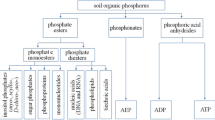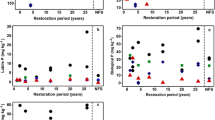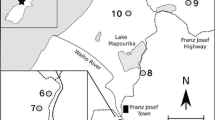Abstract
The chemical composition of soil phosphorus can vary markedly during pedogenesis, which has implications for phosphorus availability to plant and microbial communities during long-term ecosystem development. We used NaOH–EDTA extraction and solution 31P NMR spectroscopy to examine changes in soil phosphorus composition along the Haast chronosequence, a 6,500 year sequence of coastal dunes under lowland temperate rain forest on the west coast of the South Island of New Zealand. Soils along the chronosequence contained a variety of inorganic (orthophosphate, pyrophosphate, and long-chain polyphosphate) and organic (phosphomonoesters, phosphodiesters, and phosphonates) phosphorus compounds, although long-chain polyphosphates were detected only in the organic horizon and phosphonates were detected only in mineral soil. The concentrations of most compounds increased initially during the first few hundred years of pedogenesis and then declined as soils aged. However, concentrations of phospholipids, DNA, and long-chain polyphosphate all increased markedly in the organic horizon of older sites. The four inositol hexakisphosphate stereoisomers (myo, scyllo, neo, and d-chiro) accounted for a considerable proportion of the phosphomonoesters in mineral soil along the sequence (36–52 % of the organic phosphorus), but were not detected in quantifiable concentrations in the youngest mineral soil and all but one organic horizon. Concentrations of the two most abundant isomers (myo- and scyllo) declined along the chronosequence, but the scyllo isomer increased markedly as a proportion of the soil organic phosphorus as soils aged. Amorphous aluminum and iron oxides (i.e., extractable in acid-ammonium oxalate) increased continually throughout the chronosequence, indicating that the decline in inositol hexakisphosphate is due to low phosphorus availability rather than a decline in stabilization potential. Overall, these results provide further evidence that the chemical composition of organic and inorganic phosphorus pools vary markedly during pedogenesis, which has important implications for our understanding of biologically-available organic phosphorus during ecosystem development.





Similar content being viewed by others
References
Bowman RA, Cole CV (1978) Transformations of organic phosphorus substrates in soils as evaluated by NaHCO3 extraction. Soil Sci 125:49–54
Bowman RA, Moir JO (1993) Basic EDTA as an extractant for soil organic phosphorus. Soil Sci Soc Am J 57:1516–1518
Bünemann EK, Smernik RJ, Doolette AL, Marschner P, Stonor R, Wakelin SA, McNeill AM (2008) Forms of phosphorus in bacteria and fungi isolated from two Australian soils. Soil Biol Biochem 40:1908–1915
Celi L, Barberis E (2007) Abiotic reactions of inositol phosphates in soil. In: Turner BL, Richardson AE, Mullaney EJ (eds) Inositol phosphates: linking agriculture and the environment. CAB International, Wallingford, pp 207–220
Celi L, Cerli C, Turner BL, Santoni S, Bonifacio E (2013) Biogeochemical cycling of soil phosphorus during natural revegetation of Pinus sylvestris on disused sand quarries in Northwestern Russia. Plant Soil 367:121–134
Chadwick OA, Chorover J (2001) The chemistry of pedogenic thresholds. Geoderma 100:321–353
Cheesman AW, Turner BL, Reddy KR (2012) Soil phosphorus forms along a strong nutrient gradient in a tropical ombrotrophic wetland. Soil Sci Soc Am J 76:1496–1506
Condron LM, Turner BL, Cade-Menun BJ (2005) The chemistry and dynamics of soil organic phosphorus. In: Sims JT, Sharpley AN (eds) Phosphorus: agriculture and the environment. ASA-CSSA-SSSA, Madison, pp 87–121
Cosgrove DJ (1970) Inositol phosphate phosphatases of microbiological origin. Inositol phosphate intermediates in the dephosphorylation of the hexaphosphates of myo-inositol, scyllo-inositol, and d-chiro-inositol by a bacterial (Pseudomonas sp.) phytase. Aust J Biol Sci 23:1207–1220
Crews TE, Kitayama K, Fownes JH, Riley RH, Herbert DA, Mueller-Dombois D, Vitousek PM (1995) Changes in soil phosphorus fractions and ecosystem dynamics across a long chronosequence in Hawaii. Ecology 76:1407–1424
Doolette AL, Smernik RJ, Dougherty WJ (2009) Spiking improved solution phosphorus-31 nuclear magnetic resonance identification of soil phosphorus compounds. Soil Sci Soc Am J 73:919–927
Eger A, Almond P, Wells A, Condron LM (2013) Quantifying ecosystem rejuvenation: foliar nutrient concentrations and vegetation communities across a dust gradient and a chronosequence. Plant Soil 367:93–109
Giles CD, Hsu P-C, Richardson AE, Hurst MRH, Hill JE (2014) Plant assimilation of phosphorus from an insoluble organic form is improved by addition of an organic anion producing Pseudomonas sp. Soil Biol Biochem 68:263–269
Hill JE, Richardson AE (2007) Isolation and assessment of microorganisms that utilize phytate. In: Turner BL, Richardson AE, Mullaney EJ (eds) Inositol phosphates: linking agriculture and the environment. CAB International, Wallingford, pp 61–77
Huggett RJ (1998) Soil chronosequences, soil development, and soil evolution: a critical review. Catena 32:155–172
Izquierdo JE, Houlton BZ, van Huysen TL (2013) Evidence for progressive phosphorus limitation over long-term ecosystem development: examination of a biogeochemical paradigm. Plant Soil 367:135–147
Jangid K, Whitman WB, Condron LM, Turner BL, Williams ME (2013) Bacterial community composition during pedogenesis along a coastal dune system under lowland temperate rainforest in New Zealand. Plant Soil 367:235–247
Koukol O, Novák F, Hrabal R (2008) Composition of the organic phosphorus fraction in basidiocarps of saprotrophic and mycorrhizal fungi. Soil Biol Biochem 40:2464–2467
Li X, Rapson GL, Flenley JR (2008) Holocene vegetational and climatic history, Sponge Swamp, Haast, south-western New Zealand. Quat Int 184:129–138
Loeppert RH, Inskeep WP (1996) Iron. In: Sparks DL et al (eds) Methods of Soil Analysis, Part 3 – Chemical Methods. Soil Science Society of America, Madison, pp 639–664
Makarov MI, Haumaier L, Zech W, Marfenina OE, Lysak LV (2005) Can 31P NMR spectroscopy be used to indicate the origins of soil organic phosphates? Soil Biol Biochem 37:15–25
McDowell RW, Cade-Menun B, Stewart I (2007) Organic phosphorus speciation and pedogenesis: analysis by solution 31P nuclear magnetic resonance spectroscopy. Eur J Soil Sci 58:1348–1357
McKercher RB, Anderson G (1968) Content of inositol penta- and hexaphosphates in some Canadian soils. J Soil Sci 19:47–55
Murphy PNC, Bell A, Turner BL (2009) Phosphorus speciation in temperate basaltic grassland soils by solution 31P NMR spectroscopy. Eur J Soil Sci 60:638–651
Palmer RWP, Doyle RB, Grealish GJ, Almond PC (1986) Soil studies in south Westland, 1984/1985. Soil Bureau District Office Report NP 2. Department of Scientific and Industrial Research, New Zealand.
Peltzer DA, Wardle DA, Allison VJ, Baisden WT, Bardgett RD, Chadwick OA, Condron LM, Parfitt RL, Porder S, Richardson SJ, Turner BL, Vitousek PM, Walker J, Walker LR (2010) Understanding ecosystem retrogression. Ecol Monogr 80:509–529
Read DJ, Perez-Moreno J (2003) Mycorrhizas and nutrient cycling in ecosystems—a journey towards relevance? New Phytol 157:475–492
Saunders WMH, Williams EG (1955) Observations on the determination of total organic phosphorus in soils. J Soil Sci 6:254–267
Selmants PC, Hart SC (2010) Phosphorus and soil development: does the Walker and Syers model apply to semiarid ecosystems? Ecology 91:474–484
Singleton GA, Lavkulich LM (1987) Phosphorus transformations in a soil chronosequence, Vancouver Island, British Columbia. Can J Soil Sci 67:787–793
Syers JK, Walker TW (1969) Phosphorus transformations in a chronosequence of soils developed on wind-blown sand in New Zealand I. Total and organic phosphorus. J Soil Sci 20:57–64
Turner BL (2007) Inositol phosphates in soil: amounts, forms and significance of the phosphorlyated inositol stereoisomers. In: Turner BL, Richardson AE, Mullaney EJ (eds) Inositol phosphates: linking agriculture and the environment. CAB International, Wallingford, pp 186–207
Turner BL (2008a) Resource partitioning for soil phosphorus: a hypothesis. J Ecol 96:698–702
Turner BL (2008b) Soil organic phosphorus in tropical forests: an assessment of the NaOH–EDTA extraction procedure for quantitative analysis by solution 31P NMR spectroscopy. Eur J Soil Sci 59:453–466
Turner BL, Engelbrecht BMJ (2011) Soil organic phosphorus in lowland tropical rain forests. Biogeochemistry 103:297–315
Turner BL, Richardson AE (2004) Identification of scyllo-inositol phosphates in soils by solution phosphorus-31 nuclear magnetic resonance spectroscopy. Soil Sci Soc Am J 68:802–808
Turner BL, Mahieu N, Condron LM (2003a) Phosphorus-31 nuclear magnetic resonance spectral assignments of phosphorus compounds in soil NaOH–EDTA extracts. Soil Sci Soc Am J 67:497–510
Turner BL, Mahieu N, Condron LM (2003b) Quantification of myo-inositol hexakisphosphate in alkaline soil extracts by solution 31P NMR spectroscopy and spectral deconvolution. Soil Sci 168:469–478
Turner BL, Baxter R, Mahieu N, Sjögersten S, Whitton BA (2004) Phosphorus compounds in subarctic Fennoscandian soils at the mountain birch (Betula pubescens)–tundra ecotone. Soil Biol Biochem 36:815–823
Turner BL, Cade-Menun BJ, Condron LM, Newman S (2005) Extraction of soil organic phosphorus. Talanta 66:294–306
Turner BL, Newman S, Reddy KR (2006) Overestimation of organic phosphorus in wetland soils by alkaline extraction and molybdate colorimetry. Environ Sci Technol 40:3349–3354
Turner BL, Condron LM, Richardson SJ, Peltzer DA, Allison VJ (2007) Soil organic phosphorus transformations during pedogenesis. Ecosystems 10:1166–1181
Turner BL, Cheesman AW, Godage HY, Riley AM, Potter BVL (2012a) Determination of neo- and d-chiro-inositol hexakisphosphate in soils by solution 31P NMR spectroscopy. Environ Sci Technol 46:4994–5002
Turner BL, Condron LM, Wells A, Andersen KM (2012b) Soil nutrient dynamics during podzol development under lowland temperate rain forest. Catena 97:50–62
Turner BL, Wells A, Andersen KM, Condron LM (2012c) Patterns of tree community composition along a coastal dune chronosequence in lowland temperate rain forest in New Zealand. Plant Ecol 213:1525–1541
Turner BL, Lambers H, Condron LM, Cramer MD, Leake JR, Richardson AE, Smith SE (2013) Soil microbial biomass and the fate of phosphorus during long-term ecosystem development. Plant Soil 367:225–234
Vincent AG, Turner BL, Tanner EVJ (2010) Soil organic phosphorus dynamics following perturbation of litter cycling in a tropical moist forest. Eur J Soil Sci 61:48–57
Vincent AG, Vestergren J, Gröbner G, Persson P, Schleucher J, Giesler R (2013) Soil organic phosphorus transformations in a boreal forest chronosequence. Plant Soil 367:149–162
Vitousek PM (2004) Nutrient cycling and limitation. Princeton University Press, Princeton
Walker TW, Syers JK (1976) The fate of phosphorus during pedogenesis. Geoderma 15:1–19
Wells A, Goff J (2006) Coastal dune ridge systems as chronological markers of palaeoseismic activity: a 650-year record from southwest New Zealand. Holocene 16:543–550
Wells A, Goff J (2007) Coastal dunes in Westland, New Zealand, provide a record of paleoseismic activity on the Alpine fault. Geology 35:731–734
Acknowledgments
We thank Amanda Black, Andre Eger, and Victoria Nall, and (Lincoln University) for field assistance and Alex Blumenfeld (University of Idaho) and Dayana Agudo (STRI) for laboratory support. Funding for travel and consumables was provided by Lincoln University.
Author information
Authors and Affiliations
Corresponding author
Additional information
Rights and permissions
About this article
Cite this article
Turner, B.L., Wells, A. & Condron, L.M. Soil organic phosphorus transformations along a coastal dune chronosequence under New Zealand temperate rain forest. Biogeochemistry 121, 595–611 (2014). https://doi.org/10.1007/s10533-014-0025-8
Received:
Accepted:
Published:
Issue Date:
DOI: https://doi.org/10.1007/s10533-014-0025-8




